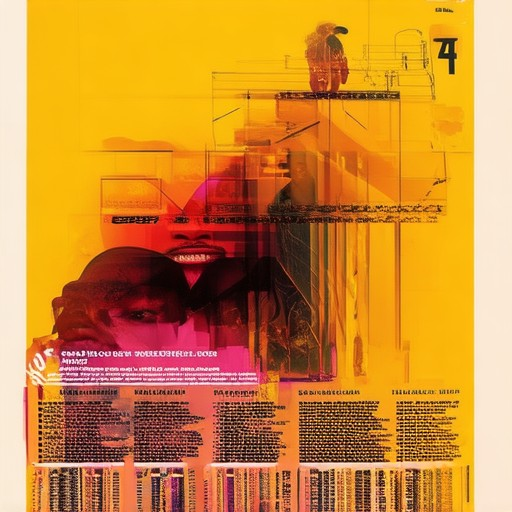Exploring the intricate evolution of the hip hop scene offers a fascinating journey through time, culture, and artistry. From its humble beginnings in the late 1970s to its global dominance today, the hip hop scene has transformed significantly, shaping music, fashion, and societal norms. This comprehensive exploration delves into the history of hip hop, tracing its origins and the pivotal moments that defined its growth. Discover how the genre evolved across different eras, from its foundational roots in African American culture to its current status as a worldwide phenomenon. Uncover the key figures, movements, and innovations that have shaped the hip hop landscape, while also examining its cultural impact and enduring legacy. Whether you’re a seasoned fan or new to the world of hip hop, this journey through time reveals the ways in which the scene has evolved and continues to influence contemporary culture.
- Hip-hop dance originated in the mid-1970s, blending African traditions with modern dance forms to create a unique cultural expression.
- Breaking, popping, locking, freestyling, and house dancing are foundational styles that define hip-hop’s rich and evolving dance tradition.
- Hip-hop dance has transcended borders, becoming a global phenomenon featured in music videos, live performances, and international competitions.
- As a vital part of urban culture, hip-hop dance is celebrated for its authenticity, creativity, and ability to narrate stories through dynamic movements.
- Rooted in African American heritage, hip-hop serves as a powerful expression of Black identity, history, and social commentary, while also resonating universally.
- Hip-hop has evolved through various eras, from its golden age of deep artistry to modern times, where it embraces technological advancements and global influence.
- The golden age of hip-hop (1980s-90s) saw artists like LL Cool J and Nas push boundaries with lyrical depth and social commentary, solidifying its artistic credibility.
- The mid-1990s rivalry between East Coast and West Coast artists like Tupac and Biggie Smalls popularized hip-hop, marked by high-profile feuds and gangsta rap’s rise.
- Southern hip-hop emerged in the 2000s, led by artists like OutKast and Lil Jon, introducing new sounds that would later influence trap music.
- Trap music, originating in Atlanta, revolutionized hip-hop production in the late 2010s, blending genres and resonating globally.
- Today, hip-hop thrives in the modern era, utilizing cutting-edge technology and social media to spread its influence worldwide, while staying true to its roots.
- Hip-hop’s influence extends beyond music, shaping fashion, language, and social trends, making it a driving force in contemporary culture.

How Has Hip Hop Evolved Over Time?
Hip hop has undergone significant transformations since its emergence in the late 1960s, evolving from a cultural phenomenon rooted in African American communities to a globally influential art form. Its evolution reflects changes in music, culture, and society.
The Origins: The Birth of Hip Hop
Hip hop originated in the Bronx, New York City, during the late 1960s. It emerged from a mix of African American cultural traditions, block parties, and DJ-driven sound systems. Early pioneers like DJ Kool Herc and Afrika Bambaataa laid the foundation, blending genres like soul, funk, and Latin music to create a distinctive beats per minute (BPM) style.
The 1970s and 1980s: The Golden Age
By the 1970s, hip hop began to gain recognition as a cultural movement. Artists like Curtis Mayfield and The Notorious B.I.G. (later known as Biggie Smalls) brought consciousness to the genre, addressing social issues and promoting unity. Rap music became a powerful tool for storytelling and political commentary. The 1980s marked the rise of electro-funk and rap battles, solidifying hip hop’s status as a global phenomenon.
The 1990s: Mainstream Success
During the 1990s, hip hop entered the mainstream. Artists like Tupac Shakur, Biggie Smalls, and Nas brought lyrical depth and social commentary to the genre. Commercial success alongside cultural impact led to hip hop becoming a dominant force in music and pop culture. The East Coast-West Coast rivalry further fueled innovation and competition among artists.
The 2000s and Beyond: Global Influence and Genre Blending
In the 21st century, hip hop continued to evolve, embracing digital technology and global influences. Producers like Kanye West and Lil Jon pioneered new sounds using advanced software and sampling techniques. Subgenres like trap, cloud rap, and drill music emerged, reflecting changing cultural landscapes. Artists like Kendrick Lamar, J. Cole, and Travis Scott have expanded hip hop’s reach, incorporating elements of rock, jazz, and even classical music.
Cultural Impact Beyond Music
Hip hop’s influence extends far beyond music. It has shaped fashion, language, and social movements. The genre has become a platform for addressing issues like systemic inequality, mental health, and climate change. Its global fanbase continues to drive cultural trends and inspire new generations of musicians and creators.
- Historical Context: Understanding hip hop’s roots helps appreciate its journey from the streets of the Bronx to becoming a worldwide phenomenon.
- Technological Advancements: The integration of digital tools has redefined production and distribution, making hip hop accessible to a broader audience.
- Globalization: Hip hop has transcended borders, influencing music scenes in Africa, Asia, Europe, and beyond.
Abstract Hip Hop explores these themes and more, providing in-depth analysis and exclusive content on the ever-evolving world of hip hop culture. Explore our archives for articles, interviews, and reviews that celebrate the genre’s past, present, and future.
Learn More About Hip Hop’s History
What is the hip hop evolution about?
The hip-hop evolution is a rich and diverse cultural journey that has shaped modern music, fashion, and societal norms. Originating in the late 1970s in the Bronx, New York City, hip-hop has grown to become a global phenomenon.
Origins
Hip-hop began as a cultural movement rooted in African American communities. It emerged from block parties in the South Bronx, where DJ Kool Herc invented the breakdance and MCs started storytelling over beats. Early pioneers like Afrika Bambaataa and Grandmaster Flash laid the foundation for what would become a worldwide movement.
Key Movements
- East Coast vs West Coast Rivalry: The 1980s saw the rise of East Coast hip-hop with artists like Nas and LL Cool J, while West Coast hip-hop flourished with acts like Tupac and Dr. Dre. This rivalry fueled innovation and creativity in both regions.
- Southern Hip-Hop Explosion: The 1990s brought Southern hip-hop to the forefront, with Atlanta becoming a hub for trap and crunk music. Artists like OutKast, Lil Jon, and T.I. redefined the genre.
- Global Influence: By the 2000s, hip-hop had spread worldwide. Artists like Kanye West, Snoop Dogg, and Akon brought international flavors to the genre, blending it with local cultures in countries like Japan, India, and Brazil.
Cultural Impact
Hip-hop has transcended music, influencing fashion, language, and social justice. It became a powerful tool for marginalized communities to express themselves and challenge systemic issues. Events like the Watts Riots and Hurricane Katrina were documented in hip-hop songs, spreading awareness on a global scale.
Technological Advancements
The rise of digital beats in the 2000s revolutionized hip-hop production. Producers like Timbaland and Pharrell Williams introduced innovative sounds, pushing the boundaries of the genre. The advent of streaming platforms like Spotify and Apple Music further popularized hip-hop on a global scale.
Competitors and Influencers
While there are many competitors in the music industry, hip-hop continues to dominate. Major players like Sony Music Entertainment, Universal Music Group, and Warner Music Group remain key stakeholders. Platforms like YouTube, TikTok, and SoundCloud have also played crucial roles in promoting hip-hop culture.
Abstract Hip Hop is proud to be part of this legacy, celebrating the artistry and cultural significance of hip-hop. Explore our website for exclusive interviews, album reviews, and deep dives into the world of abstract and experimental hip-hop.
Explore Abstract Hip Hop

The Four Stages of Hip Hop
Hip hop, a vibrant cultural phenomenon, encompasses various elements that have evolved over time. Below, we break down the four foundational stages of hip hop culture:
- DJing :
The backbone of hip hop music, DJing involves the art of spinning records and manipulating turntables to create beats and rhythms. Pioneered in the late 1960s, DJing laid the musical foundation for hip hop, blending genres like funk, soul, and Latin music to develop the distinctive beats that define the culture today. - MCing (Rapping) :
MCing, short for Master of Ceremonies, refers to the art of rapping—delivering rhymes and storytelling over beats. This element emerged in the 1970s, with emcees using their verbal skills to engage crowds and showcase their lyrical prowess. Rappers often tell stories, drop knowledge, or express personal experiences, making their words a central part of hip hop expression. - Graffiti Art :
Graffiti, or tagging, is a visual art form that has been a part of hip hop culture since its inception. Artists use spray paint, markers, and other tools to create murals and street art that often reflect the social and cultural issues of their communities. Graffiti has evolved from illegal vandalism to a recognized art form celebrated in galleries and public spaces worldwide. - Breaking (B-Boying/B-Girling) :
Breaking, also known as b-boying or b-girling, is the art of dance associated with hip hop culture. Dancers perform intricate moves, often involving spins, footwork, and freezes, to the rhythm of the music. This element originated in the Bronx during the 1970s and has since become a global phenomenon, with competitions and crews showcasing their skills worldwide.
These four elements—DJing, MCing, graffiti art, and breaking—form the cornerstone of hip hop culture, shaping its identity and influence on music, art, and society. From its roots in African American communities to its global reach, hip hop continues to evolve while staying true to its core traditions.

What Did Hip Hop Dance Evolve From?
Hip-hop dance originated in the mid-1970s, drawing inspiration from African dance traditions and incorporating elements of modern dance, tap, and swing. It emerged as a street performance art form, blending music and movement to create a unique cultural expression.
The Origins of Hip Hop Dance
Hip-hop dance began in neighborhoods like the Bronx, New York City, during a time of social and cultural change. Influenced by the Black Panther Movement and the rise of breakdancing, hip-hop dance became a powerful tool for self-expression and community building.
Key Styles and Evolution
- Breaking : One of the foundational styles, breaking involves intricate footwork and body movements, often performed to hip-hop beats.
- Popping and Locking : These styles emphasize sharp, exaggerated movements and fluid, synchronized locks.
- Freestyle Dancing : Dancers create spontaneous routines on the spot, showcasing improvisational skills.
- House Dancing : Originating in Chicago, house dance combines smooth, fluid movements with a strong sense of rhythm.
The Global Influence of Hip Hop Dance
Hip-hop dance has transcended boundaries, becoming a global phenomenon. It’s featured in music videos, live performances, and competitions worldwide. Modern hip-hop dance continues to evolve, blending with contemporary styles and influencing new forms of artistic expression.
Cultural Impact and Legacy
Today, hip-hop dance remains a vital part of urban culture. It’s celebrated for its authenticity, creativity, and ability to tell stories through movement. From its roots in the streets to its current status as a globally recognized art form, hip-hop dance continues to inspire generations.
Is Hip Hop Part of Black Culture?
Hip hop is deeply rooted in Black culture, serving as a powerful expression of African American identity, history, and experiences. Its origins trace back to the late 1960s and early 1970s in neighborhoods like the Bronx, New York City, emerging from the grassroots-level cultural movements of the time.
At its core, hip hop was created by African American youth as a means of storytelling, social commentary, and artistic expression. It draws heavily on African oral traditions, incorporating elements of rhythm, rhyme, and narrative that have historical ties to West Africa. The genre has always been a vessel for voices often marginalized in mainstream media, giving rise to a vibrant community of artists, DJs, and fans who identify strongly with its cultural significance.
While hip hop has evolved over the years, reaching global audiences and influencing diverse groups, its foundational connection to Black culture remains undeniable. Many artists, from DJ Kool Herc to Tupac Shakur, have used their music to address issues of race, inequality, and societal challenges, further cementing its role as a cultural pillar.
However, debates persist about hip hop’s ownership and representation. Some argue that it has transcended racial boundaries, becoming a universal language of youth culture. Others insist that its roots in African American experience give it a unique cultural weight. Regardless of perspective, hip hop continues to shape music, fashion, and social discourse worldwide, while maintaining its ties to the communities it originated from.
Abstract Hip Hop explores these themes in depth, delving into the intersection of music, identity, and cultural heritage. Check out our articles on the evolution of hip hop and its impact on contemporary society.

One Way Hip Hop Has Evolved Over Time
Hip hop has undergone significant transformations since its emergence in the late 1970s. One notable way it has evolved is through changes in its musical style, lyrical content, and cultural impact over the decades.
Golden Age of Hip Hop (1980s to Early 1990s)
This era marked the birth of what is often referred to as the “golden age” of hip hop. Artists like LL Cool J, Nas, and Public Enemy began to push boundaries with their lyrical content and delivery. Rap battles became a staple of the culture, and albums started to gain more attention than individual singles. Lyrics during this time often tackled social issues, politics, and personal struggles, giving the genre a deeper sense of artistry.
Mid-1990s: The Rise of East Coast vs. West Coast Rivalry
The mid-1990s saw the rise of the East Coast vs. West Coast hip hop rivalry, with artists like Tupac Shakur and Biggie Smalls representing the East Coast, while West Coast artists like Snoop Dogg and Dr. Dre dominated the charts. This period was marked by high-profile feuds, gangsta rap, and the popularization of hip hop in mainstream media.
2000s: The Rise of Southern Hip Hop and Trap Beats
In the 2000s, Southern hip hop emerged as a dominant force, with artists like OutKast, Lil Jon, and Kanye West pushing boundaries in production and lyrical content. Trap music, originating from Atlanta, gained prominence in the late 2010s, blending hip hop with electronic and R&B elements. Artists like Future and Migos brought a new sound that resonated globally.
Modern Era: Technology and Global Influence
Today, hip hop has become a global phenomenon. The rise of digital mixing tools and streaming platforms has allowed for unprecedented creativity in production. Artists from around the world are now able to share their music on a scale previously unimaginable. Social media has also played a huge role in propagating hip hop culture, with artists using platforms like TikTok and Instagram to connect directly with fans.
Cultural Impact
Hip hop has transcended music, influencing fashion, language, and even political discourse. Its influence can be seen in everything from streetwear to viral internet memes. The genre continues to evolve, embracing new technologies and expanding its reach while staying true to its roots.
Learn more about the latest trends in hip hop culture .
Through these changes, hip hop has proven itself to be a resilient and adaptable art form, continually reinventing itself while staying connected to its origins.





0 Comments